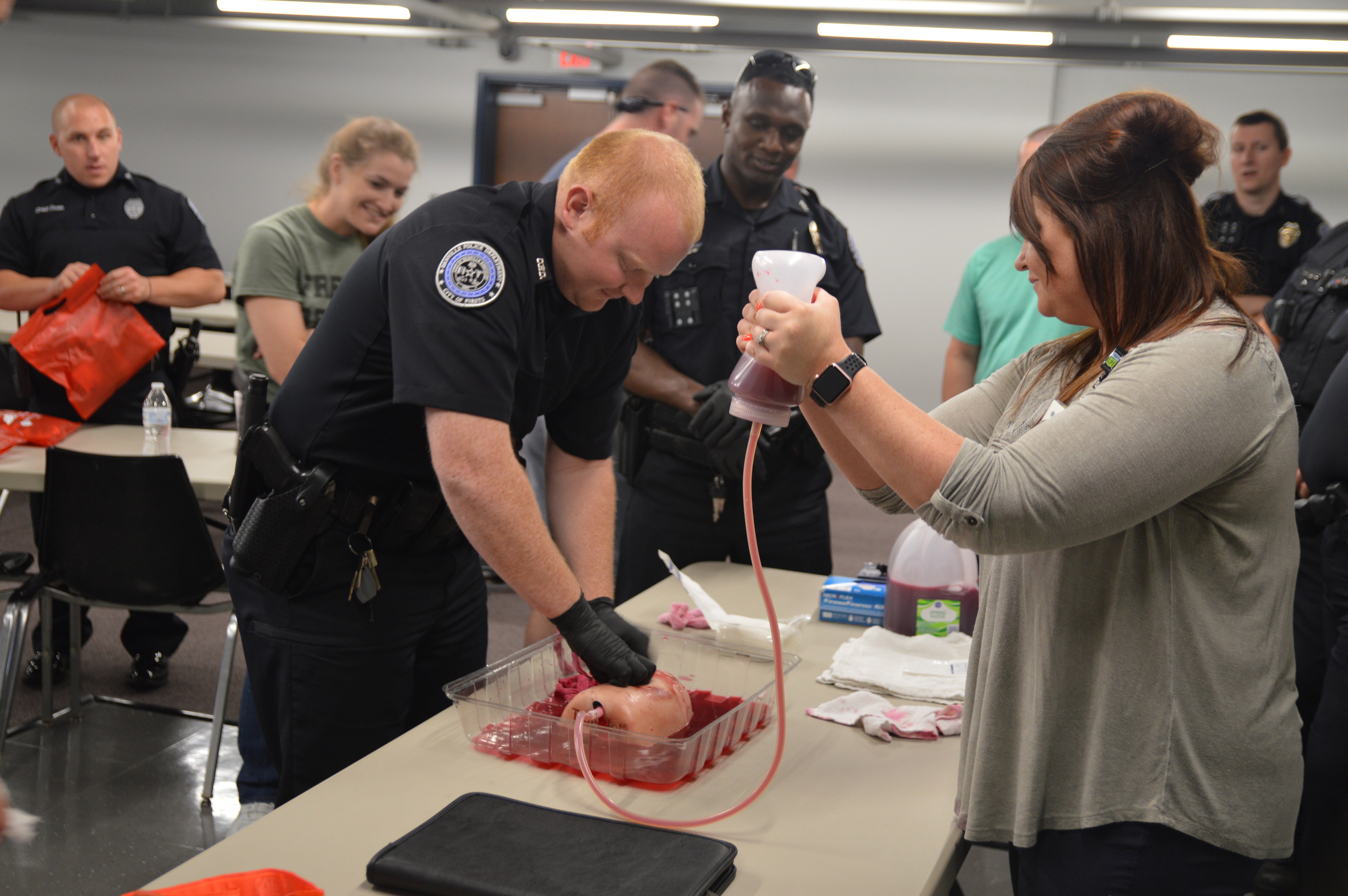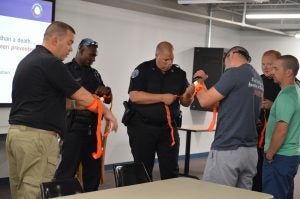Officers given training during first-ever National Stop the Bleed Month
Published 6:22 pm Thursday, May 30, 2019

- Ben Ray Danville Police officer practices packing a bullett hole as Katy Jo Aaron, trauma coodrinator, supervises. (Photo by Bobbie Curd)
May 2019 is the first ever National Stop the Bleed Month, a nationwide campaign that highlights the importance of stop-the-bleed training. According to EMS Director Mike Rogers, bleeding is the No. 1 cause of death in trauma. It is also 100% preventable.
Across the country, free bleeding control classes were offered to the public in order to further the goal set by the American College of Surgeons — the organization wants everyone in the U.S. trained about what to do during a bleeding emergency.
Rogers held a recent training for Danville Police officers, showing them not only how to apply a tourniquet to another individual, but how to use one on themselves.
A training station was also set up for officers to try their hand at packing a bullet wound hole. Katy Jo Aaron, the trauma coordinator for Ephraim McDowell Regional Medical Center, gave officers pointers as she supervised.
Boyle EMS partnered with the hospital and Air Evac Lifeteam 56 to put tourniquet kits together and offer the trainings.
“We need first responders to learn how to stop the bleeding, of course … but also any citizens.” Rogers has presented the training to local churches and most all area schools, and made sure they had kits available to use.
He told officers the stop-the-bleed mission was set forth by the Department of Defense and the American College of Surgeons after the 2012 Sandy Hook Elementary School shooting in Connecticut, where six adults and 20 children lost their lives.

EMS Director Mike Rogers, far left, works with Danville Police on how to properly use a tourniquet on themselves. The officers are Jude Remillion, Capt. James Monroe, Ben Ray, Sgt. Chris Wentz and David Lewis.
“We have a lot of data surrounding tourniquets now,” he said. “When I first started with EMS, you didn’t put a tourniquet on unless the patient was almost dead.”
However, Rogers said medical personnel found out that at that point, it’s way too late. Battlefield data indicates tourniquets are good to be used for up to eight hours.
“The only thing you risk is nerve damage, but that’s better than death and not much of a risk. So just put them on early.”
In wound-packing, Rogers said when he first started, “you put a bandage over it … Now, if they’ve got a hole, we pack it. You put your fingers in the hole, whether it’s a laceration or bullet hole. It will hurt.”
Rogers encouraged officers to keep tourniquets somewhere on their person at all times, but said they probably need to keep two on hand. And for self-application, he said some of the more fit officers may have to use two, for instance, if it’s to treat a wound in the upper leg area.
After going through the presentation showing different wounds and how to apply tourniquets,
Rogers asked officers, “What about the pelvic area?”
He said one of the things we don’t think about is bleeding in the hip area. Rogers said the hips can hold up to two liters of blood. “As a paramedic, we won’t notice that until their blood pressure is low, and at that point it’s too late.”
So, he says now their treatment plan has changed. When they do an assessment on a patient and they grimace when their hip area is touched, a junctional tourniquet is used, which is applied around the pelvis. Rogers plans to get one for the PD, as well.
Rogers also has been researching a special combat gauze for law enforcement to use. “The difference is regular gauze will just soak up blood. Combat gauze has a hemostatic agent in it and will actually stop the bleeding within three minutes in a major artery,” he said.
Boaters should all carry at least one tourniquet on their watercraft, he said, and non-medical personnel can get a tourniquet for around $10 online to keep at home. “And woodworking — table saws are the worst. Chainsaws, anything like that, have (tourniquets) in your car and in your work space at home.”
Rogers said he feels like Danville and Boyle County are “way ahead” where working on an inter-agency system of care is concerned. “We work so well with the hospital, the police and fire departments … We don’t treat it like ‘Boyle County EMS has a stroke patient.’ No, there’s an emergency in Boyle County and it’s a stroke patient. It applies to the whole emergency response system.”
Rogers commends the police department for always being open to working with EMS. “When we asked the police department if we bought the AEDs (automated external defibrillators) if they’d use them — well, we bought 10, and they use them. They actually deployed two and used them … I think that puts us above a lot of places in the state.”
Rogers offers the tourniquet training, as well as others, on-site at area businesses and other organizations. To set one up, call (859) 238-1133.






